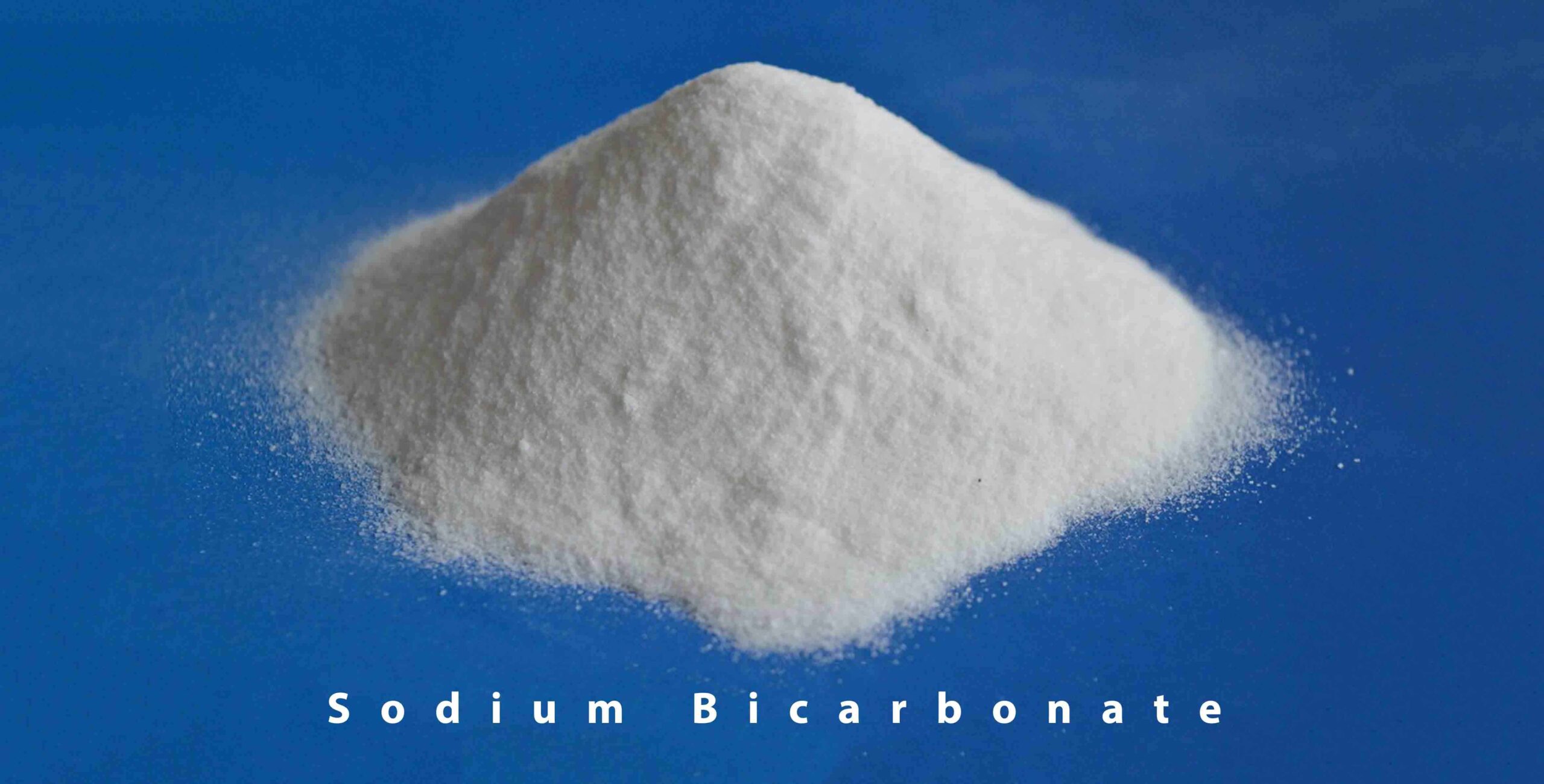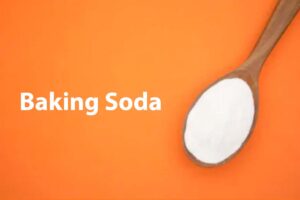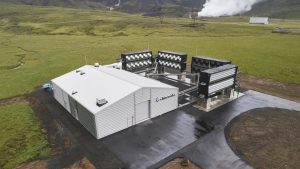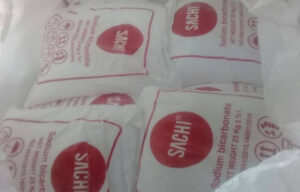Sodium bicarbonate; Features and applications

What is sodium bicarbonate? Is sodium bicarbonate a mineral? Sodium bicarbonate with the IUPAC name of sodium hydrogen carbonate (usually known as baking soda or soda bicarbonate), is a chemical compound with the formula NaHCO3. This compound is a mineral salt composed of sodium cation (Na+) and bicarbonate anion (HCO3–).
Baking soda is a white solid with a crystalline appearance, however, it is sold as a powder with fine grains. Baking soda is a little salty and has almost alkaline properties. A mineral compound containing this salt is found in salty water springs and mineral springs.
Contents
A Look at sodium bicarbonate history
In 1791, French chemist “Nicholas Leblanc” could for the first time produce sodium carbonate which is called soda ash. In 1846, two American bakers, “John Dwight” and “Austin Church” established the first baking soda production factory of sodium carbonate and carbon dioxide in America.
Is sodium bicarbonate a mineral? Sodium bicarbonate was introduced by a person named Rudyard Kipling in the 1800s. A compound that could be used in commercial fishing in order to prevent the decaying of newly hunt fish. This application was the widest usage case of sodium bicarbonate at that time.
In 1919, an American senator announced that baking soda can cure Spain Flu! Some studies of that time showed what baking soda is and what treatment effects it has for diseases like the flu.
Sodium Bicarbonate production methods
Baking soda industrial production (sodium bicarbonate industry):
In order for you to better understand what sodium bicarbonate is, it is necessary to get familiar with this substance production. Sodium bicarbonate is industrially produced of sodium carbonate:
Na2CO3 + CO2 + H2O →2 NaHCO3
Soda ash extracted as Trona mine stone, is solved in water and treated with carbon dioxide. Solid Sodium bicarbonate is extracted of this solution as sediment.
About Solvay procedure, sodium bicarbonate is a mediatory compound in sodium chloride, ammonia gas and carbon dioxide compound. However, this product has less purity (75 percent):
NaCl + CO2 + NH3 + H2O → NaHCO3 + NH4Cl
Although it does not have significant commercial and productive value, however, sodium bicarbonate is also made of carbon dioxide reaction with sodium hydroxide water solution:
CO2 + NaOH → NaHCO3
Sodium bicarbonate production through the extraction of the mine:
Nahcolite natural mineral deposits contain sodium bicarbonate mineral compounds. These mines are created in Eocene period at the time of forming green river in Colorado. These sediments are deposited over time as a result of river bed evaporation. Sodium bicarbonate commercial extraction in this region is performed using normal techniques of underground extraction such as cavity extraction, drum excavation, and longitudinal extraction like coal extraction.
Limited amounts of the product are received on the surface with the extraction of bicarbonate sodium solution through warm water pumping of Nahcolite beds and retrieving “Nahcolite” solved in the surface. This extraction is performed through a crystallization procedure with a natural cooler.

Baking soda properties
What is sodium bicarbonate? Sodium bicarbonate is an amphoteric compound. Due to Carbonic Acid and hydroxide ion formation, water solutions are almost alkaline.
Sodium bicarbonate could be used as washing factor for eliminating any acid impurities of “raw liquids” and production of a more pure sample. Sodium bicarbonate and acid reaction produces a mineral salt and carbonic acid which is easily analyzed to carbon dioxide and water:
NaHCO3 + HCl → NaCl + H2CO3
H2CO3 → H2O + CO2
Sodium bicarbonate reacts to acetic acid (present in vinegar) and produces sodium acetate, water and carbon dioxide:
NaHCO3 + CH3COOH → CH3COONa + H2O + CO2
Sodium bicarbonate reacts to bases such as sodium hydroxide and compose carbonates:
NaHCO3 + NaOH → Na2CO3 + H2O
Thermal analysis of sodium bicarbonate
In 80-100 Celsius degrees (176-212 Fahrenheit degrees), sodium bicarbonate is slowly analyzed to sodium carbonate, water and carbon dioxide. This transformation speed is more in 200 Celsius degrees temperature (392 Fahrenheit degrees):
2 NaHCO3 → Na2CO3 + H2O + CO2
Through more heating, carbonate is transformed to oxide (more than 850 Celsius degrees):
Na2CO3 → Na2O + CO2
Sodium bicarbonate’s physical and chemical characteristics table
| Compound name | |
| Sodium bicarbonate iupac id Sodium hydrogen carbonate | |
| Other names: Nahcolite-soda bicarbonate-bicarbonate- bakery baking soda | |
| Identification index | |
| CAS Number | 144-55-8 |
| EC Number | 205-633-8 |
| E number | E500 |
| PubChem CID | 516892 |
| Properties and characteristics | |
| Sodium bicarbonate formula | NaHCO3 |
| Molar scale | 84.0066 g mol−1 |
| Apparent form | White Crystallines |
| Odor | Odorless |
| Density | 2.20 g/cm3 |
| Melting point | Analyzed to sodium carbonate from 50 celsius degrees |
| Solubility in water | 69 g/L (0 °C) 96 g/L (20 °C) 165 g/L (60 °C) |
| solubility | 0.02 wt%acetone 2.13 wt% in Methanol in -22 °C Insoluble in Ethanol |
| Structural property | |
| Crystal structure | Mono crystal |
| Thermochemical | |
| Thermal capacity (c) | 87.6 J/mol K |
| Molar entropy (So298) | 101.7 J/mol K |
| Formation standard enthalpy(ΔfH⦵298) | −950.8 kJ/mol |
| Gibbs free energy (ΔfG˚) | −851.0 kJ/mol |
| Related compounds | |
| anions | Sodium carbonate |
| cations | Ammonium bicarbonate Potassium bicarbonate |
Other similar compounds | Sodium bisulfate Sodium hydrogen phosphate |
Baking soda applications
what are sodium bicarbonate applications?
Sodium bicarbonate application in food industries
Sodium bicarbonate is baking soda or sodium hydrogen carbonate. This industrial ingredient is used in edible grade, mainly in making bread and bakery. It can be used as baker’s yeast, (welding in bread dough, buffer atmosphere). Other cases could be seen bellow:
Sodium bicarbonate as ingredient in making baking powder:
Necessary in a dough volume increase in making different types of bread, cookie, cake, cracker and wafer, and baking powder. Baking powder consists of three types of main composing substances:
A main factor: sodium bicarbonate
An acidic factor: for instance, Sodium Acid Pyrophosphate (SAPP) or citric acid
A volume factor: for instance, cornstarch
Standard relation is 30/40/30 weight percent (starch/ Sodium Acid Pyrophosphate/sodium bicarbonate). Yeast action is along with Carbon dioxide freedom. These reactions could be seen in the following figures:
Two chemical reactions (2a and 2b reactions):


2a reaction for carbon dioxide has higher performance than 2b. 2a reaction starts when modifiers are solved at the time of dough provision. 2b reaction starts with being heated.
2a reaction amount depends on different parameters including selection of the acidic substance and sodium bicarbonate particles size. Sodium bicarbonate with larger particles has more dissolution time than smaller ones (see the following table) & so, it affects reaction speed. Reaction speed for larger particles is slower than smaller ones.

However, it should be noted that in case of excessive sodium bicarbonate existence, an undesirable reaction occurs (see the following figure reaction).

This is a saponify reaction between sodium bicarbonate and free fatty acid existing in formulation (=fatty acid which is made up of substances like butter or cream). This reaction produces a fatty acid salt which induces undesired taste like metal taste in boiled substances.
- Baking soda as PH buffer in food industries:
Sodium bicarbonate could be used as PH buffer. This means it can regulate and maintain solution PH.
With such property, some nutrients formulations contain sodium bicarbonate as PH buffer. All types of ready to cook noodle, and also energy drinks and ready coffee or tea contain this compound. Therefore, using sodium bicarbonate has two main benefits. The first point is better control of final product PH so that it makes edible product better consistency and shelf life feasible.
Sodium Bicarbonate regulates PH and prevents creation of an acidic environment which leads to bacteria augmentation. Secondly, sodium bicarbonate makes a better feeling in the individual in digestion.
- Sodium bicarbonate agent of “foam or gas” creation in nutrients:
Chemical reaction which occurs in production of foam or ebullition in making bread or cake is the same as 2a reaction which was mentioned in the previous section. Sodium bicarbonate and an acidic factor react with each other in order to free carbon dioxide.
This property is used for carbonated drinks formulation. It is due to these reactions effect that carbon dioxide solved in drinks is freed as gas bubble.
This eruption property is also used for producing foam in powder drinks such as cappuccino or powder energy drinks. This reaction is occurred when powder is mixed in water.
Powder baking soda has faster dissolution time in water and produces strong foam with fast spark impact. On the contrary, larger particles have longer dissolution time and produce weaker foam.
Sodium bicarbonate industrial applications
- The human body needs a determined PH criterion for health. When acidic nature is created more than usual in any of the body systems, sodium bicarbonate injection or pill can quickly counter body PH increase by forming an acidic/alkaline reaction. Kidney chronic diseases, heartburn, kidney stones, increase in uric acid and metabolic acidosis can all be cured with sodium bicarbonate.
- Sodium bicarbonate effectively cleans teeth and gums and decreases the mouth’s natural acidity. If mouth acidity is more than the natural amount, it can lead to mouth infections. Therefore, so many toothpastes without fluoride have sodium bicarbonate.
- 25 percent of bestial baking soda used throughout the world is used as bestial food.
- In wool, silk, and leather coloring, industrial-grade sodium bicarbonate is used.
- In plastic production industries and complex polymers, sodium bicarbonate is used as a purifier and catalyst. Sodium bicarbonate analysis leads to carbon dioxide freedom. This feature is often used in plastic and rubber production.
- While cooking peas or other vegetables, sodium bicarbonate is added in order for these vegetables to get smoother.
- Baking soda and olive mixture lead to olives texture smoothness and fragility.
- Most of the products which eliminate face spots have baking soda as one of their ingredients in the formulation.
- Sodium bicarbonate controls sulfide odor existing in drainage refineries. Besides, it counters microorganisms’ biological growth.
- Due to the pH increase, suitable alkalinity of water and sodium bicarbonate is maintained through filtration.
- From the chemical point of view, sodium bicarbonate is used for desulfurization in the way of different chimneys. This procedure refines industrial gases before being spread into the atmosphere.
- Sodium bicarbonate’s infective property has led to its invaluableness in drug industries. This compound eliminates bacteria and funguses through sterilization.
- Libraries managers and book collection aires know that the oldness odor in damaged or older books is eliminated through sprinkling sodium bicarbonate among book sheets.
- Dry fire fighting capsules which contain chemical substances used in houses and careers have sodium bicarbonate for confronting fire derived from electrical flow.
- Deodorant: Baking soda can help eliminate sweat odor by making it less acidic, though there’s limited research on whether this work.
- Fridge odor neutralizer: Baking soda can help freshen a smelly fridge by neutralizing bad odors rather than just masking them.
- Kitchen cleaner: Baking soda can help clean kitchen surfaces and appliances by removing grease, stains and dirt. It can also unclog drains and deodorize garbage disposals
- Laundry booster: Baking soda can help brighten clothes, remove stains and odors, and soften fabrics. It can also be used as a natural fabric softener.
- Carpet cleaner: Baking soda can help clean carpets by removing dirt, dust, and odors. Sprinkle some baking soda on your carpet, let it sit for 15–20 minutes, then vacuum it up.
- Shoe deodorizer: Baking soda can help deodorize shoes by absorbing moisture and odor-causing bacteria. Sprinkle some baking soda inside your shoes, let it sit overnight, then shake it out in the morning.
- Silver polish: Baking soda can help polish silverware by removing tarnish and restoring shine. Make a paste of baking soda and water, apply it to your silverware with a cloth or sponge, then rinse and dry.
- Canker sore treatment: Baking soda can help treat canker sores by reducing inflammation and pain. Rinse your mouth with a solution of baking soda and water several times a day until the sore heals
- Canker sore treatment: Baking soda can help treat canker sores by reducing inflammation and pain. Rinse your mouth with a solution of baking soda and water several times a day until the sore heals.
- Insect bite remedy: Baking soda can help relieve itching and swelling from insect bites by neutralizing the venom or irritant. Make a paste of baking soda and water, apply it to the affected area, then rinse after 10 minutes.
- Sunburn relief: Baking soda can help soothe sunburned skin by reducing inflammation and restoring pH balance. Add some baking soda to a cool bath or make a compress with baking soda and water, then apply it to the sunburned area.
- Skin exfoliator: Baking soda can help exfoliate your skin by removing dead skin cells and unclogging pores. Make a paste of baking soda and water, gently massage it onto your face or body, then rinse with warm water.
- Splinter removal: Baking soda can help draw out splinters from your skin by increasing blood flow to the area. Make a paste of baking soda and water, apply it to the splinter, cover it with a bandage, then remove it after a few hours.
- Foot soak: Baking soda can help soften your feet and remove odors by dissolving dead skin cells and neutralizing bacteria. Add some baking soda to a basin of warm water, soak your feet for 15–20 minutes, then dry them thoroughly
source: Healthline
the lattest application for sodium bicarbonate
Sodium bicarbonate, also known as baking soda, is a key ingredient in a new technique for capturing carbon dioxide from the air and storing it in the ocean, according to a paper in Science Advances. The technique could help reduce greenhouse gas emissions and ocean acidification by removing excess carbon dioxide from the atmosphere and the ocean.
Ocean acidification and global warming are primarily caused by carbon dioxide. It is emitted by human activities such as burning fossil fuels and accumulates in the air and water. To limit climate change, we need to not only cut down emissions but also remove some of the carbon dioxide that is already in the air.

The new technique, developed by researchers from China and the US, uses a special material that can capture carbon dioxide from the air more easily and cheaply. The material is made of copper nanoparticles that enhance the reaction between carbon dioxide and water. The captured carbon dioxide is then turned into sodium bicarbonate by reacting it with seawater. The sodium bicarbonate can then be released into the ocean at a low concentration, where it can help buffer the acidity of the water.
The researchers claim that their technique could capture up to three times more carbon dioxide than existing methods and reduce the cost of direct air capture by 40%. They also say that their technique could have environmental and social benefits by reducing greenhouse gas emissions and ocean acidification.
The technique is still experimental and needs more testing and improvement before it can be used on a large scale. The researchers also need to assess the potential impacts of releasing sodium bicarbonate into the ocean on marine life and human health. However, they hope that their technique could offer a promising solution for tackling climate change.
source: CNN
Sodium bicarbonate safety
Sodium bicarbonate makes eye and skin irritation. It could be harmful if absorbed through the skin. In case of accidental swallowing, it would be harmful. The main impact is alimentary tract irritation.
Chronic damages due to long-term contact with this mineral substance include liver and kidney injury.
- Baking soda chemical consistency:
Sodium hydrogen carbonate is analyzed while heated. This compound might be analyzed within humid weather or water.
Prevent this substance contact with unsuitable substances. Dust production, excessive heat, temperatures more than 50 Celsius degrees (122 Fahrenheit degrees), and facing moist weather or water, are unsuitable factors for this compound.
Sodium bicarbonate is unsuitable with other substances such as strong oxidizer factors, acids, mono ammonium phosphate, sodium, and potassium alloy.
Dangerous products analyzed of this compound include carbon monoxide and carbon dioxide.
Baking soda packing

Sodium bicarbonate packings exist in polyethylene or polypropylene bags weighing 25 kg and 50 kg along with shrink cover and on pallets and also 1000 gr jumbo bags.
Sodium carbonate packages that weigh less than 1 kg are currently offered in 500 gr weight. This product has laboratory grade and is made in Germany.
Sodium bicarbonate maintenance conditions
The environment for maintaining packages and bags special for sodium bicarbonate must have suitable ventilation. Minimize dust production and gathering for this substance. Be careful that this compound is not in contact with your eyes and skin and if it gathered on your cloth, quickly change and wash your clothes.
Sodium bicarbonate packages must be kept in a dry and cool place and the dish door be firmly closed.
Market, buy and sale, and export status of sodium bicarbonate
Sodium bicarbonate is one of the most common and used industrial chemical compounds. This substance exists in the market in edible, industrial, and laboratory grades. The drug version of sodium bicarbonate could be mentioned as this compound’s edible grade. Sodium bicarbonate is used so much in foods. Baking soda with Sachi, Pars, and Fajr-e Parisian brands is presented in the market.
Baking soda marketing is possible in client-needed packages. For receiving updated prices and acquaintance with the method of ordering this substance, you can refer to “Shimico” website, industrial chemical substances commerce reference.
 Top 10 sodium bicarbonate suppliers in Iran
Top 10 sodium bicarbonate suppliers in Iran
Sources:
Last Seen















Users Comment
Quality articles is the keey to attract the peoploe tto payy a vissit thhe
weeb site, that’s whast thuis wweb ssite is providing.
my blog post: free porn
How Urea Can Hydrate and Exfoliate Your Skin
Sodium carbonate| Soda ash; features and applications
Copper Sulfate; Features and applications
Sulfur; Features and applications
Zinc sulfate; Features and applications
Urea; Features and applications
Ammonium Sulfate; Features and applications
What is the use of caustic soda? An Overview of the caustic soda uses
Caustic soda flakes and the methods of production
Analysis of September manufacturing trends in Asia
The impact of growth in major Asian economies on petrochemical demand
Aramco loan $2 billion to Petro Rabigh to cover cash shortfall
16Th International ArabPlast 2023
International Iran Conmine 2023
International Iran Nano 2023
17Th International Iranplast Fair 2023
12th International Composite Expo 2023
International IFarm Agro Fair 2023
22Nd International Paint Resin Coatings Fair
Sodium carbonate| Soda ash; features and applications
Copper Sulfate; Features and applications
Sulfur; Features and applications
Zinc sulfate; Features and applications
Urea; Features and applications